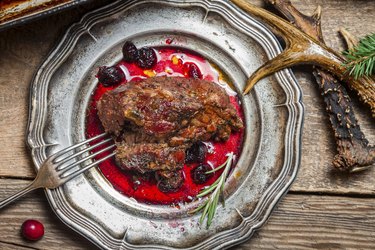
Whey protein and lean meat both provide dietary protein. Whey proteins are a group of proteins found in cow's milk, where they make up 20 percent of the total milk protein, according to the U.S. Dairy Export Council. The words "lean meat" usually refer to the less-fatty cuts of beef, lamb, pork and game such as venison. Each of these proteins has advantages and disadvantages. Consult a health care professional before using whey protein supplements.
Sources and Types
Video of the Day
Whey protein and lean meat both contain high levels of amino acids to build and maintain muscle tissue. Whey protein supplements are available as concentrate, isolate or hydrolysates, according to Medical News Today. Concentrate has less fat but contains lactose and carbohydrates. Isolate is lower in available protein but the fat and lactose have been removed. Hydrolysates are more easily absorbed but more expensive. Lean beef comes from the chuck, round, sirloin and tenderloin. Lean pork and lamb are found in the tenderloin, loin chops and leg.
Video of the Day
Nutrient Comparison
Whey protein does not contain vitamins or fiber, but vitamins and minerals are usually added to supplements. Whey protein is not a complete food and does not provide the same level of nutrients as a whole food such as meat. Lean meat supplies nutrients such as protein, B vitamins, vitamin E, iron, zinc and magnesium, according to the U.S. Department of Agriculture. Lean meat does not contain carbohydrates or fiber but does have some fat. Beef graded "choice" instead of "select" or "prime" is usually leaner.
Serving Size
The recommended daily allowance for protein is 56 grams for men and 46 grams for women, according to the Centers for Disease Control and Prevention. As a supplement, 20 grams to 25 grams of whey protein is adequate for most people, but athletes may need twice that amount during heavy training or competition. A serving of lean meat is about 3 ounces and provides 21 grams to 24 grams of protein.
Cooking
Whey protein does not have to be cooked and can be added to prepared foods such as smoothies, oatmeal or mashed potatoes. Whey protein is added to nutrition bars and made into powders or beverages. Meats do need to be cooked and lean meat is often more tender if braised or stewed for several hours. You can reduce the natural fat content of meat even more by cutting off visible fat, cooking by broiling or roasting instead of frying and draining the fat after the meat is cooked.
Considerations
Whey protein and lean meat are different sources of protein. Although whey protein may be more convenient in some ways, meat provides more nutrients, such as vitamins and minerals. Whey protein is normally used as a supplement to a balanced diet rather than an integral component of the diet. Consult a health care professional before you take whey protein supplements.
- University of Illinois: Creatine and Whey Protein Supplements
- New Mexico State University Co-operative Extension Service: Fitting Meat, Poultry and Fish Into a Healthy Diet
- United States Department of Agriculture: Why Is It Important to Make Lean or Low-Fat Choices From the Protein Foods Group?
- Centers for Disease Control and Prevention: Protein
- U.S. Dairy Export Council: Whey Protein Heat Stability
- Journal of Sports Science and Medicine: Protein: Which is Best?
- Medial News Today: What Is Whey Protein?